
Travel Guide
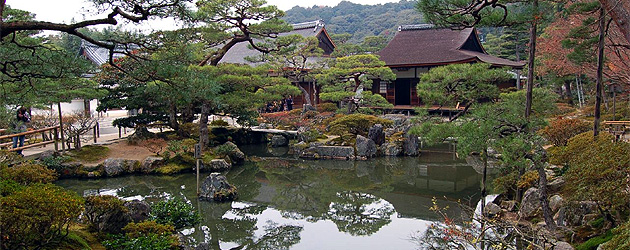
Introduction
Ginkakuji Temple (Temple of the Silver Pavilion), officially named Jishoji Temple (Temple of Shining Mercy), founded in 1482, is one of the outstanding temples of the Muromachi era (1338-1573). Ginkakuji Temple is a Zen temple which belongs to the Shokokuji Temple branch of the Rinzai sect of Zen Buddhism.
Located in the foothills on the east side of Kyoto, the place is full of serenity and tranquility with a deep background of history. The temple is famous for its two-story Kan’non Hall, Silver Pavilion, which takes its name from the anecdote that Shogun Ashikaga Yoshimasa, the temple's patron, intended to cover the pavilion with silver leaf in imitation of the Kinkakuji Temple (Golden Pavilion) built by his grandfather. Although no silver was ever applied, the name lives on. Ginkakuji Temple was designated as UNESCO World Cultural Heritage in 1994.
The main building Silver Pavilion is a hybrid of Japanese culture, ancient Chinese culture and aesthetic value of Zen Buddhism. The incompleteness of the silver coating leave an empty space in our mind and it is up to our imagination of how it looks like with the silver appearance.
Ginkakuji Temple was a center of contemporary culture, known as the Higashiyama Culture of Muromachi period in contrast to the Kitayama Culture of his grandfather's times. Unlike the Kitayama Culture, which remained limited to the aristocratic circles of Kyoto, the Higashiyama Culture had a broad impact on the entire country. The arts developed and refined during the time include the tea ceremony, flower arrangement, noh theater, poetry, garden design and architecture.
The temple complex includes lovely Japanese gardens. Attributed to the great landscape artist and architect Soami (1465-1523), they consist of two contrasting sections that combine harmoniously. The first, a green pond garden overlooked by the Silver Pavilion, is a composition of rocks and plants designed to afford different perspectives from each viewpoint. The second garden which is named Ginsha-dan features two sculpted mounds of sand. It sparkles in the moonlight, giving it the nickname Sea of Silver Sand.
Onin War was a civil war that lasted 10 years (1467–1477) during the Muromachi period in Japan. A dispute between Hosokawa Katsumoto and Yamana Sozen escalated into a nationwide war involving the Ashikaga shogunate and a number of daimyo in many regions of Japan. Just after the finish of the Onin war, the temple was built, while the population suffered from famine, destruction and death, Yoshimasa was enjoying watching the garden, enjoying tea, incense and other esoteric pleasures. Yoshimasa moved to this lavishing palace complex in 1483, the 2nd year of the construction.
Despite Yoshimasa's intention to cover the structure with a distinctive silver-foil overlay, this work was delayed for so long that the plans were never realized before Yoshimasa's death. The present appearance of the structure is understood to be the same as when Yoshimasa himself last saw it. This "unfinished" appearance illustrates one of the aspects of "wabi-sabi" quality.
History
Like Kinkakuji Temple, Ginkakuji Temple was originally built to serve as a place of rest and solitude for the shogun Ashikaga Yoshimasa in 1482. The retirement villa was modeling after Kinkakuji Temple (Golden Pavilion), Yoshimasa’s grandfather's retirement villa at the base of Kyoto's Kitayama (northern mountains). In 1485, Yoshimasa became a Zen Buddhist monk. After his death on January 27, 1490, the villa and gardens became a Buddhist temple complex, and given the name Jishoji Temple, taken from his posthumous religious title, Jishoin.
According to temple records, the Ginkakuji Temple originally consisted of twelve buildings. Only two buildings, the Ginkaku and the Toku-do, survived the disastrous fire that occurred in the Tembun Period (1532-1555). By the advent of the Meiji Period (1600-1868), the Ginkakuji Temple had fallen into disrepair, but was eventually restored thanks to municipal support and private donations.
After extensive restoration, started February 2008, Ginkakuji Temple is again in full glory to visit. The garden and temple complex are open to the public. There is still no silver foil used. After much discussion, it was decided to not refinish the lacquer to the original state. The lacquer finish was the source of the original silver appearance of the temple, with the reflection of silver water of the pond on the lacquer finish.
What to see
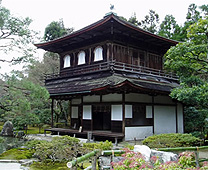 |
Kan’non Hall (Silver Pavilion) The two-storied Kan’non Hall (Kan’non Den), is the main temple structure with a serene wooden exterior. The pavilion's two stories are constructed in two different architecture styles. The first floor, Shinku-den is built in Shion style, traditional Japanese residential architecture style, and the second floor Cho-onkaku is a Chinese temple style having Katoumado in the panel walls and a Chinese sliding door. The first floor housed an image of Jizo Bosatsu and the second floor contains a statue of Kan’non, the Buddhist goddess of mercy. The bronze phoenix on the roof facing east constantly guards Ginkakuji Temple and is dedicated to Kan’non Bosatsu, the Goddess of Mercy. The interior of the building is not open to the public. |
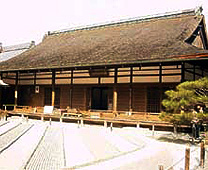 |
Hojo (Hondo) Hojo (Hondo) is the main hall of the temple complex and dates back to Edo period of 1624 to 1644. The principal image of worship inside the hall is a statue of Shaka Nyorai. This building is fragile and therefore closed to general public. There is a fantastic sand garden called Ginshadan in front of the building. Hojo was designated as Kyoto City Designated Cultural Properties in 1992. |
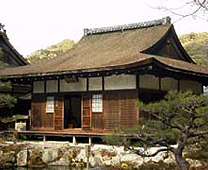 |
Togu-do Togu-do dates back to the temple's foundation. The front room of Togu-do is where Yoshimasa is thought to have lived, and the statue of the priest is Yoshimasa himself. The back room, called Dojin-sai ("Comradely Abstinence"), was used for tea ceremonies. Dojin-sai is considered to be the oldest extant example of Shoin architecture, its simple but classic design served as a model for traditional tea pavilions that emerged across Japan in the following century. The building and its study room are not usually open to the public. |
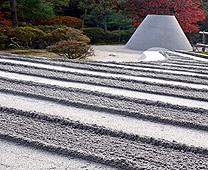 |
Ginsha-dan and Kogetsu-dai There is a large sand garden located near the entrance. The garden is called Ginsha-dan (Sea of Silver Sand), with a massive sand cone named Kogetsu-dai (Moon Viewing Platform). Ginsha-dan is said to be modeled based on the shape of the West Lake in China. In fact, when the moon rises in the eastern mountains of Tsukimachi, the sea of sand seems to generate waves in the moonlight. Kogetsu-dai is designed to accentuate the reflection of the moon in the sea of sand. It is said that, as seen from the second floor of the Ginkakuji Temple, the cone resembles a full moon reflected on a silver sea. |
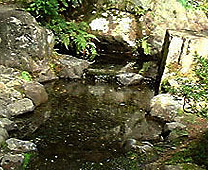 |
Ocha-no-i and Sengetsusen It is said that Yomisama collect the water from here for tea ceremony. Because of its quality, the water is still used in 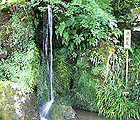 the tea ceremony. Adjacent to the Ocha-no-i is a stream of waterfall called Sengetsusen. Many visitors toss coin for lucky. the tea ceremony. Adjacent to the Ocha-no-i is a stream of waterfall called Sengetsusen. Many visitors toss coin for lucky.
|
Travel Advice
Sightseeing
- Before you reached the temple, you need to walk an uphill road from the bus stop towards the temple. Along the road, there are many shops selling food, drinks and souvenir.
- Visitors can see Ginkakuji Temple through the live camera on the Japanese official website of Ginkakuji Temple. The live image will be renewed every 3 minutes.
- The ticket is very unique, it looks like a talisman, that wishing your family safe, good fortune and prosperity.
- Kinkakuji Temple and Ginkakuji Temple are two of the most famous temples in Kyoto. When people talk about the most amazing thing they saw, they almost always talk about their visit to Kinkakuji Temple. Ginkakuji Temple is not as luxury as Kinkakuji Temple, however it is hard to mention one without the other. Both are visited, daily, by hundreds if not thousands of people. Both have a long history, however Ginkakuji Temple was built after Kinkakuji Temple and its final intended look has been debated for centuries.
- There is a path called Tetsugaku no michi (Philosopher’s Walk) which is a two kilometer long pedestrian stone path that begins around Ginkakuji Temple and ends in the neighborhood of a temple named Nanzenji. The path is named after Nishida Kitaro who was said to practice meditation while walking this route on his daily commute to Kyoto University. The path follows a canal which is lined with hundreds of cherry trees. It is nice to walk on this path surrounded by cherry trees with fresh green leaves.
- After passing by the Togu-do, the walking path then takes visitors through Ginkakuji Temple's moss garden, which features ponds with islands and bridges, little streams and various plants. The path climbs a hill behind the buildings from where there are nice views of the entire temple grounds and the city beyond. At last, visitors can enjoy once more some closer views of the Silver Pavilion before exiting the grounds.
Ginkakuji Temple is one of the city's most popular sites, and it is almost always crowded, especially during the spring and autumn. We strongly recommend visiting right after it opens or just before it closes.
Abbot of Ginkakuji Temple
The great Zen monk Muso Soseki (夢窓疎石, 1275-1351), who had been selected as the first abbot of the Shokokuji, was designated the honorary abbot of this temple as well. Hosho Shuzai, a tonsured adopted son of Yoshimasa, was chosen as the second (actually the first functioning) abbot. Later on, most of the abbots of the Ginkakuji Temple were selected from aristocratic families such as the Konoe (近衛家 Konoe-ke), a branch of the Fujiwara clan.
Visit
| Address | 2 Ginkakuji Temple-cho, Sakyo-ku, Kyoto-shi, Kyoto | |
| Phone | 075-771-5725 | |
| Admission | Adult: 500 yen Student: 300 yen |
Adult: over 15 Student: 6 to 14 |
| Hours | 08:30 to 17:00 March 1 to November 30 09:00 to 16:30 December 1 to February 28(29) |
Entry until 30 minntes before closing |
| Closed | Open 7 Days a Week | |
| Duration | 30 minutes | |
| Getting There | By Train 25 minutes ride by City Bus No.5 or 17 bound for Kyoto from JR Kyoto Station to the Ginkakuji Temple-michi bus stop, then walk approximately 7 minute. By Car Take Meishin Expressway to the Kyoto-minami exit. It is approximately 8 kilometers 40 minutes from exit. |
|
| Parking | Parking available | |

